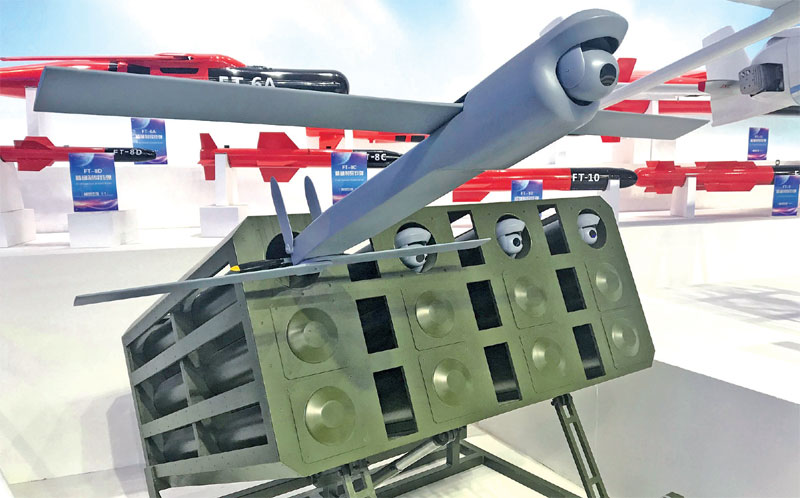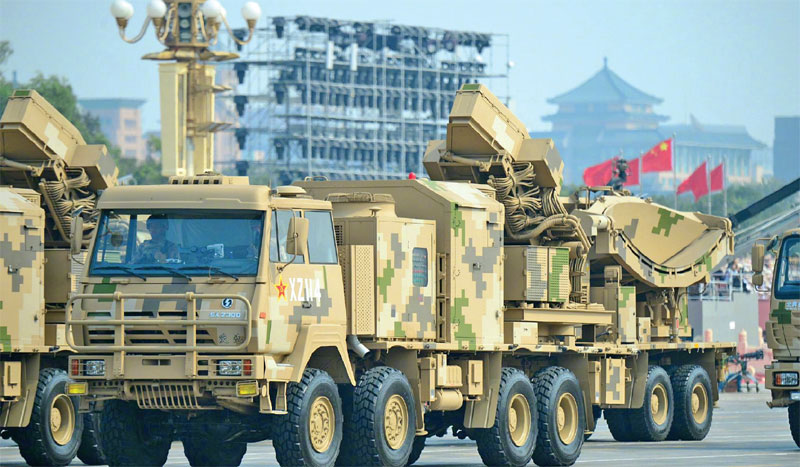The Integrated C4I Complex has contributed significantly to increasing PLAGF’s combat effectiveness
Prasun K. Sengupta
A large part of the People’s Liberation Army’s Ground Forces (PLAGF) organisational reforms have been enabled by new information warfare systems, including vehicles and terminals supporting the Integrated C4I Complex (ICC) that was developed in early 2004 and first introduced to the PLAGF across all branches in 2010. The successful development of the ICC was recognised with the state award for Scientific and Technological Progress Special Class, an award typically given to one to three projects of great significance to the country every year. The ICC unified hundreds of disparate C4ISTAR systems developed by different branches and departments of the PLAGF in the 20 years leading up to 2010, and has arguably contributed more to increasing the PLAGF’s combat effectiveness than any other system in recent memory. Within most Combined-Arms Brigades, C4ISTAR networks link every vehicle and select infantry such as forward observers and recce-scout elements together into a singular battlefield map accessible to all terminals. This allows all vehicles to constantly be aware of friendly positions and identified enemy positions as well as the status of all nodes, including their health, munitions count, fuel load, current orders, etc. The ground commander is able to seamlessly take in the battlefield picture, including recommendations from his staff and orders from above, and issue complex orders with a keyboard, a process much more efficient and accurate than traditional voice radio.

Some Combined-Arms Brigades (CAB) have also compiled databases of the performance parameters of their systems and personnel in a variety of environments and situations. This helps units to construct more realistic training scenarios, make fairer calls during confrontation exercises, and find the most effective methods of doing things supported by empirical data. If the Brigade is subject to electronic attack, standard operating modes should be able to sidestep the disruption by frequency-hopping or other signals processing magic. If the attack is especially sophisticated or powerful, friendly EW assets—both organic and higher-echelon—can respond in the electromagnetic spectrum or use support measures to locate the source of the disruption and task fires with its destruction. Failing that, the network has the option to transmit simpler and more powerful packets that are difficult to obfuscate completely, up to and including Morse code. Wired communications can also be used between nearby stationary elements. As a last resort, signals flags are carried aboard every fighting vehicle in the Brigade.
Real-time ISR assets directly supporting the ICC are a range of tactical unmanned aerial systems (UAS), which include the truck-launched JY-203 UAS equipped with a Ku-band synthetic aperture radar sensor; the Aisheng BZK-008 (also called CH-91) that is designed for reconnaissance of the terrain and airspace, the implementation of observation and patrol missions, aerial photography and aerial photography of the terrain, and monitoring and control; the Sky Saker FX-500 reconnaissance UAS for field tube/rocket artillery forward observation; and the ASN-301 loitering delta-winged UAS with a pusher propeller that is employed as a ‘killer-drone’.
Conduct of Offensive Land Campaigns
During operations, a PLAGF offensive group will advance in preparation for an assault against an enemy mechanised task force that has taken up a defensive position. The offensive group is required to annihilate the enemy task force in order to weaken the enemy’s overall defensive strength and provide an approach route for follow-on forces. The reconnaissance group will first deploy in an advance guard position, with order to reconnoitre enemy defensive positions and identify potential weak points and strong points. Two frontline attack groups will comprise the bulk of the main assault. They will fix the enemy and enable actions by the depth attack and thrust manoeuvre groups. The depth attack group will be positioned to exploit any weaknesses in the enemy’s defences. This group will attempt to conceal its axis of advance in order to surprise the enemy. The thrust manoeuvre group, consisting of an Armour Battalion, a Mechanised Engineer Battalion, and a Rocket Battery, will wait in the rear area to exploit the successful attack of the depth attack group. The firepower group, comprising a Heavy Howitzer Battery and a Heavy Rocket Battery, will wait to deliver decisive indirect fire anywhere on the battlefield. IW and EW groups will stand by to conduct EW and deception operations, aimed primarily at fooling the enemy’s sensors, deceiving the enemy commander, and suppressing enemy communications.
One of the frontline attack groups will position itself in a support-by-fire position, engaging an enemy unit and fixing them in position. At the same time, the other frontline attack group will conduct a limited attack against the enemy’s left flank, testing the strength of the enemy’s defences. These two actions, conducted in concert with one another, are intended to confuse the enemy commander about the location and axis of the main assault, forcing him to commit reserves early. Reconnaissance units will engage enemy scouts, preventing them from effectively reconnoitring friendly units and ensuring that the enemy commander remains ignorant about the location and direction of the main assault. The depth and thrust groups will next move under concealment to their initial attack positions. As the frontline attack groups conduct their attacks, the offensive group commander will develop his understanding of the situation, and finalise the axis of the main assault. Combat power will be concentrated along this axis. The firepower group will conduct a fire-assault against the enemy’s rear area, disrupting enemy’s command-control-communications networks and causing casualties. EW and IW will directly conduct electronic warfare and information warfare against the enemy’s command-n-control networks, with their main effort being focussed on deceiving the enemy about the location and axis of the main assault.

The enemy commander, deceived into thinking that the main effort is targetting his left flank, will commits his reserve in a counter-attack against the northern frontline attack group. This group will rapidly transition to a defensive posture and begin a deliberate retrograde operation, intended to over-extend the enemy’s counter-attack force and eventually isolate them from their command. The commander, having identified the enemy’s centre as vulnerable, will commit the depth attack group in a decisive assault. Their objective is to breach the enemy’s main defensive line and isolate the two enemy flanks. The other frontline attack group will conduct an assault against the enemy’s right flank, fixing the enemy unit and preventing it from reinforcing the group under assault in the centre. The thrust group will position itself to exploit the breach created by the depth attack group. The firepower group will conducts a fire-assault against the enemy’s centre in support of the depth group’s assault. The EW group will commence its decisive effort, suppressing enemy communications in order to electronically isolate enemy units and confuse response to the main assault. The IW group will transition to information attack operations, attempting to increase the enemy units’ perception of isolation.
The thrust manoeuvre group will conduct the decisive deep assault into the enemy’s rear area, targetting command posts, supply areas, artillery units, and potential escape routes. This will complete the isolation of enemy units and compromise the enemy’s overall defensive position. The thrust manoeuvre group will also conduct a hasty attack against the exposed flank of the enemy’s counter-attack force, ensuring that they cannot be redeployed and maintaining their isolation. The frontline attack and depth groups will conduct storming attacks against the isolated and depleted enemy units. Local fire-support will be integrated with manoeuvre to either destroy or force the withdrawal of enemy units. Assaults will be coordinated as much as possible to ensure that the enemy cannot reinforce units under attack. Firepower assaults will target retreating enemy units, disrupting their movement and ensuring that retrograde actions cannot be mounted. EW and IW groups will then shift their focus to disrupting adjacent enemy units from reinforcing the now-defeated enemy unit, and on preventing the enemy’s higher echelons from communicating with the defeated unit.
The cover group will deploy a mix of reconnaissance and light infantry units into the frontal blocking zone. These units will conduct reconnaissance and counter-reconnaissance missions while screening the main body. MANPADS sections will establish ambush zones along potential aerial avenues of approach. The frontier defence zone will be occupied by the frontier defence group. The main line of defence will comprise two key defence points each defended by a mechanised CAB. Self-propelled howitzer Batteries will provide fire-support and SPAAG sections will be in direct support. The depth defence group will comprise two Armoured CABs supported by a heavy towed howitzer Battery, a rocket Battery, and a SHORADS Platoon. This group will be charged with conducting the decisive counter-attack against the enemy’s main effort. The reserve group will consist of a Mechanised CAB. It will await orders to block the enemy’s advances or to support the depth group’s counter-attack.

Two enemy Mechanised Brigades begin an attack on the defensive group’s position. Reconnaissance units will conduct counter-reconnaissance operations against enemy scouts. Mechanised CAB units in the cover group will conduct spoiling hit-and run attacks against the enemy, forcing the latter to deploy early and slowing progress through the frontal blocking zone. The firepower group will deliver fire-assaults against high-value enemy units, and the EW group will simultaneously attempt to suppress enemy communications and deceive enemy collection systems. The frontier defence group will entrench itself around the key defensive points and prepare to conduct a blocking action.
Reconnaissance units will continue to conduct counter-reconnaissance operations against advancing enemy scouts to prevent detection of the disposition and axis of the main counter-attack. The cover group will commence spoiling attacks and raids against the enemy’s main effort, causing disruption and forcing early deployment. These attacks will be continuous and will be intended to canalise the enemy’s main effort, directing it to the point in the frontier defensive zone where the main counter-attack is planned. The frontier defence group will conduct strong resistance against enemy attacks on key defensive positions. The enemy will attempt to fix the two CABs and destroy them in detail, but entrenchments and firepower will blunt the attack. The CABs will conduct a retrograde action, falling back slowly and blocking enemy penetrations into rear areas. The depth group will begin to move toward the counter-attack position. By this time, the enemy’s position and axis of advance will be well-known, and the commander will carefully choose the time and place for the counter-attack.

The cover group will continue to conduct counter-reconnaissance operations against enemy scouts. Mechanised Infantry elements of the cover group will conduct attacks against enemy scouts, forcing their withdrawal and exposing the flanks of the enemy assault group. The frontier defence group will continue to conduct blocking actions against the enemy’s supporting attacks, preventing penetrations and slowing the enemy’s advance. Firepower will be concentrated on the enemy’s main effort. Tube and rocket artillery plus electronic attack will be massed on the target in order to disrupt movement, reduce cohesion, and cause casualties. The depth group will conduct its counter-attack assault. Despite being outnumbered, the depth group will achieve local superiority through mobility, deception, and the effective use of firepower. The depth group will next assault the enemy’s main body head-on, attempting to destroy the enemy’s momentum and cohesion. The combat reserve group will be deployed in an attack on the enemy’s exposed flank in an attempt to isolate the enemy’s main body and force the enemy’s withdrawal.
The cover group will maintain contact with the retreating enemy, employing firepower to keep enemy forces off-balance and ensure that the latter cannot quickly reconsolidate. Having suffered heavy casualties during its blocking actions against superior forces, the frontier defence group will move to rear areas for consolidation and refit, becoming the new reserve group. The original depth and reserve groups will occupy the key defensive positions and begin entrenching, preparing for the next enemy assault and providing a strong position from which to begin offensive operations in the sector.

